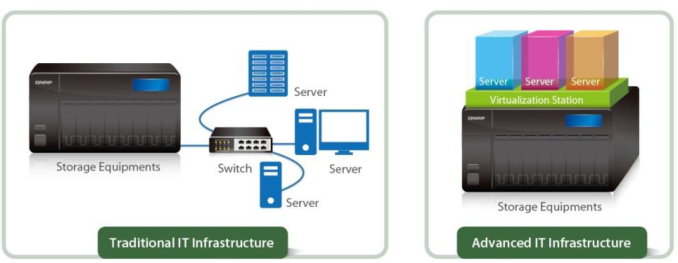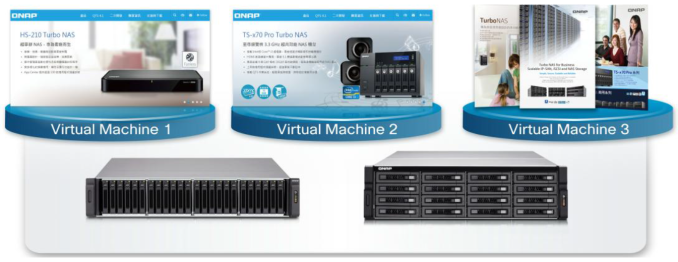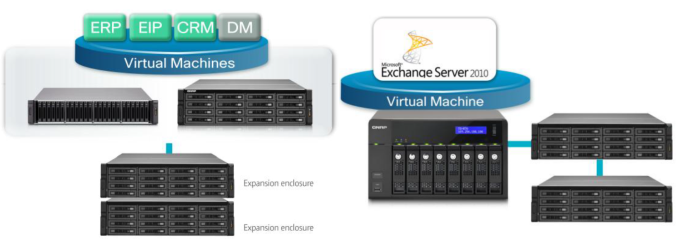NAS Units as VM Hosts: QNAP's Virtualization Station Explored
by Ganesh T S on August 18, 2014 10:15 AM EST- Posted in
- NAS
- Storage
- Virtualization
- QNAP
QNAP's Virtualization Station
The Virtualization Station package in QTS 4.x supports the installation of multiple operating systems in the VMs. QNAP contends that applications installed on VMs can improve the NAS compatibility (say, reading and working with CAD files can be achieved by installation of the appropriate software in the VM when such software is not available as a QTS package). The more obvious benefit is the aggregation of IT infrastructure.
The obvious benefits of VMs translate to the Virtualization Station package - efficiency in deployment, operation and management of systems.
Traditional NAS units carrying virtualization certifications (such as 'VMware Ready', 'Citrix Ready' and 'Windows Server Certified') provide support for virtualization by offering up storage in an easy-to-use manner (say, as iSCSI targets). Hardware-acceleration such as VMware VAAI and Windows ODX help in reducing the load on the server side by making the NAS do more of the work related to the storage (such as cloning of LUNs / copying data from one part of the LUN to another without clogging up the network links etc.). With Virtualization Station, the NAS itself can act as a hypervisor.
The Virtualization Station package allows running of multiple applications on different OSes at the same time. With the TS-451, however, only one guest OS can be active at a given point of time. Opening of files using VM-installed applications presents a number of benefits - there is no need to utilize the network bandwidth to download the file for opening through a local application - this is particularly useful for remote offices where data may have to travel outside the SMB's intranet. Under the same circumstances, avoiding the file's transfer through the network can also enhance security. Maintaining the data in a VM on the NAS also ensures availability (using QNAP's RAID implementation). QNAP's security apps (AV engines as well as firewall) provide added protection. The data on the Turbo NAS can be mounted via iSCSI or Samba on the VM. We will look into the practical aspects in the next section.
Even though the package doesn't allow for direct import of VHD files for creation of VMs, a wide variety of formats (OVA, OVF, QVM, XML and VMX) are supported in the import function. Similar to most other hypervisor solutions, we also have support for snapshots - these record VM RAM and volume ISO status at a given point in time for later roll-back (if necessary).
QTS also allows for assigning different VMs to different users, preventing accidental power-off or any other similar interruptions due to user errors. In terms of added flexibility, power scheduling of the VMs can also be set up.
In their marketing spiel, QNAP talks about four different use-cases for Virtualization Station:
- IIS web server: The package can allow a single QNAP NAS to host multiple web servers by operating existing web pages and databases on a VM. The NAS provides high-speed dedicated connections for each web server and large storage capacity.
- ERP / CRM systems: With a high-end QNAP NAS (Xeon-class CPU and 10 GbE) utilizing SSD caching, these applications can be provided excellent computing resources while ensuring continued data availability using the RAID storage of the NAS in the back-end.
- Microsoft Exchange Server: Many SMBs / SMEs already run their Exchange Server as a VM. Doing it on a QNAP NAS allows large storage capacity for the mail content. Data backup strategies can be executed easily and capacity expansion is also much simplified. From the end-user perspective, archived e-mails can be browsed without downloading.
- Windows Active Directory Server: A VM running this could be on the QNAP NAS and there would be no need for a separate physical machine on the network to run this.
All the use-cases highlighted above target SMB / SME applications. However, our focus today is on the TS-451 which targets enthusiasts and power users in the SOHO / home consumer category.













38 Comments
View All Comments
kmob - Monday, August 18, 2014 - link
Ganesh, thanks is as always for a very thorough yet readable feature.To consolidate some of my machines, I was weighing purchasing a 'dumb' NAS (like the QNAP or Synology) and a small i7 or Xeon box running ESXi. Digging into your research on this QNAP, I stumbled on articles about people upgrading the QNAP x70 series boxes with i7 or Xeon 1265 processors and RAM for some beastly VM performance on the NAS. This seems like an outstanding application of this QNAP Virtualization Station on more robust hardware at a reasonable price (for one box).
Thanks for getting my gears turning! I just ordered a QNAP 670 and a Xeon 1265L v2.
coburn_c - Tuesday, August 19, 2014 - link
This article is confusing and poorly written. You start off with paragraphs of patronizing explanation on virtual machines but never discuss this NAS box you are testing. The first hardware specs I see are of a test machine? I had to go to the manufacturer website to see what abysmal specs the NAS box actually had.As for the substance.. I've run ESXi on a nettop before.. it's great. I wouldn't run it on a nettop that's also running my net shares, especially not a SOHO one. More importantly, I wouldn't run some off-brand crap, I'd install ESXi.
ganeshts - Tuesday, August 19, 2014 - link
Thanks for the note. Majority of the other comments on this review don't echo your sentiments (probably because they have already been through the first part of the TS-451 review where I had indicated that the review would be in three parts - and specifically mentioned that discussion of the virtualization aspects would be the second piece).I do agree that new readers might find it a bit confusing as to what the exact specs and performance of the TS-451 are. I have added this statement in the initial section for this purpose: We have already looked at the performance aspects of the TS-451 in an earlier review [ http://anandtech.com/show/8298/qnap-ts451-bay-trai... ].
wintermute000 - Tuesday, August 19, 2014 - link
Its neat but I think its aiming for a pretty niche market.- want virt
- dont want 'real' virt host
- only want 1 low spec VM
DanNeely - Wednesday, August 20, 2014 - link
With the single VM limit, IMO it's more about being able to run unofficial packages without risking your warranty by SSHing past the vendors front end interface and safeguards. Other than potentially trying to stop users from shooting themselves in the foot, the hard single VM limit doesn't make a lot of sense. While there's not enough hardware to run multiple heavy client OSes; you could run a several small headless *nix images to isolate applications before maxing the system out.Wisefoxx - Wednesday, August 20, 2014 - link
Virtualisation station from Qnap is my first foray into VM's, I found it to be a fantastic addition to QTS. What's more with the 470 pro (4,6 or 8 bay) you can upgrade the processor to give you that little extra. I have a 45w i7 pro + 16gb ram installed and run multiple VM's. Such an upgrade path works well and gives you more confidence in the V-station platform.Insomniac - Thursday, November 27, 2014 - link
Some people are reporting that they are able to run 16 GB of RAM (8 GB x 2) in the x51 series. Can you confirm that is true?